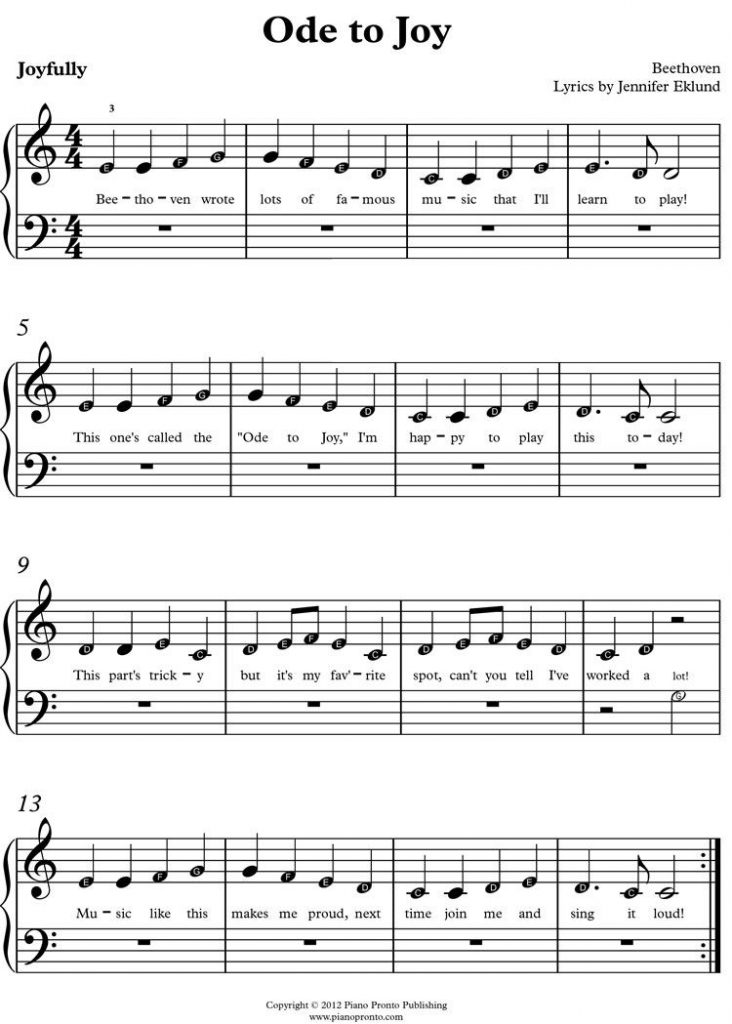Since I’ve started teaching recorder almost 5 years ago, Ode to Joy is one of the songs that I like teaching. For one, it’s based on a popular symphonic melody and it helps introduce students to classical music and a famous composer. There’s so much you can do with this song.
I would just like to record the process of teaching this song as I’ve made so many revisions with it. Hopefully the lesson plan that follows would be helpful for the novice general music teacher.

The sheet music above is really a good one that I’ve found and used over the years. It’s plain to see that the lyrics are direct and easy for primary kids to absorb. Although the notes are not the ones that I would use in teaching recorder, the lyrics are really wonderful!
Here is the following process or lesson plan that I would like to suggest:
- Teach students to sing the lyrics by rote. Accompany student’s singing on the piano or mp3.
- With the help of the recorder as reference, teach the note fingering while singing the notes in melody. Do so in one bar phrases where the students repeats it after the teacher.
- Ask the students how many notes are being used in the song and they should answer you 6 notes e.g. B, A, G, C, D’ and low D.
- Repeat Step 2 a few times until students are fluent in reciting the note names while demonstrating the fingering.
- Allow students to work in pairs or group to practice.
- Reassemble the students as a whole class and sing the note names while playing note fingerings.
- Allow students to play the recorder in phrases while teacher recite the bar phrases. Do this at least two times to internalise the melody notes.
- Allow students to work in pairs or group again to practice.
- Reassemble the students as as whole class and play the song together while teacher recites the bar phrases.
- Play the whole song together with accompany on piano or mp3.
- Assess students development/improvement by having the students to play in group while teacher accompanies the song. This allows different groups of students to rest or assess others playing.
I find the students assessment method at the end of the process very useful as I can identify the strengths and weaknesses of the students in small groups. In this way, time is not wasted too. Such group assessment also allows weak students to feel less intimidated and they feel that they can blend in the group if they can play some of the easier passages.
The weakness of this process is that the students do not learn to read the music.
Hence, I would like to suggest the following after finishing the process above:
- Write out each bar of the music in separate pieces of A4 paper.
- Place them in the middle of the classroom floor like pieces of jigsaw puzzle and have the students stand around them.
- Instruct the students to identify and arrange the music according to the Ode to Joy melody. Give them some hints that some parts are similar or repeated in different phrases. [At this point, the students should already know how BAG notes look like on the music staff. ]
- Check the arrangement of notes and have the students play and read the notes. They should be more aware now how the music look like and they will feel motivated to read and play the notes.
After this, music appreciation and history studies can be introduced to supplement the Ode to Joy studies.
Related posts
- Resources of Opera Music Lessons
- Getting Started On Asynchronous Music Lessons
- Transpose Chrome Extension: A Free and Useful Tool for Music Transcription and Practice
- Diwali Music Lesson Ideas
- Gong Xi Gong Xi – Chinese New Year Tune for Chrome Music Lab
- Mid-Autumn Festival | Mooncake Festival | Moon Themed Music Lesson Ideas


